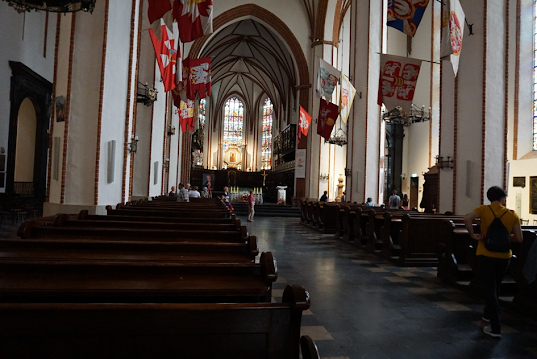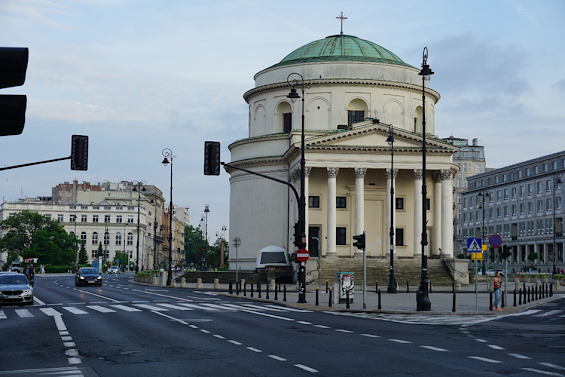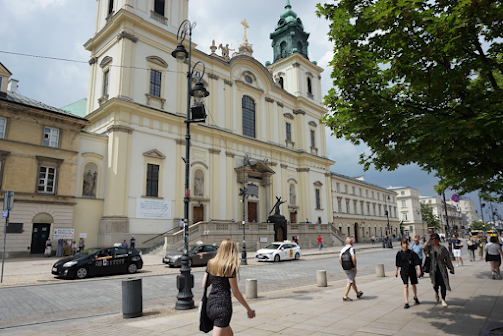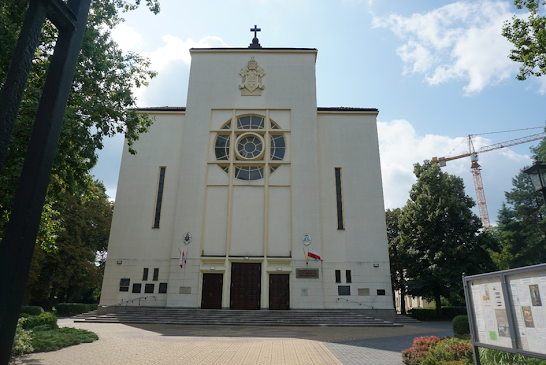Churches in Warsaw
Cemeteries in Warsaw
#Warsaw tour guide #Warsaw city guide # guided tour in warsaw #Warszawa tour guide #Warszawa city guide #guided tour in Warszawa
For anyone interested in churches, Poland is a remarkable country. The churches span various historical periods, often built with the finest craftsmanship available to society. Exploring the many churches provides insights into both the city’s development and the church’s influence on society.
People actually attend church in Poland
Approximately one-third of Poland’s population attends church every Sunday. While this percentage is somewhat lower in large cities, it still represents a significant part of community life. The predominant religion is Roman Catholicism, but it is perhaps more Polish in character than strictly Roman. Polish churches often display national symbols, reinforcing their distinct national identity.
Two exceptional churches
On my standard tours of Warsaw, I usually go to the Church of St John the Baptist in the Old Town, and if I’m taking a group to the Palace in Wilanów, we also usually pop over to the monumental God’s Providence, which is a 10-minute walk from the palace, in the middle of a modern residential area.
Short list of 10 religious sites in Warsaw
I’ve tried to make a short list of ten religious sites that you should see if you like churches and you are visiting Warsaw. However, it’s an impossible task to make a short list, as there are a lot of large and impressive churches, but there are also all the smaller churches around the city, each of which can give the visitor a great experience. So, take this list as a guide, but otherwise enter the churches you come across on your walk. They’re usually open during the day and generally welcome visitors.
Be quiet inside the church
It’s a good idea to remove any headgear if you’re a man, don’t flash your camera too much and speak softly if you absolutely need to talk. There will often be people sitting on the benches who are simply in the church to pray or feel the presence of God, and it’s best to avoid disturbing them.
Cemeteries in Warsaw
Grave sites are something special in Poland, and even in small local cemeteries in the countryside, you can find tombstones that are true works of art. Every cemetery is home to businesses specialising in stone carving and marble, and families often spend large sums of money on such monuments.
The cemeteries are scattered throughout the city, but here are just three of the most impressive, where most of Poland’s great daughters and sons rest if they are buried in Warsaw.
November 1st is something special
If you happen to be in Poland on November 1st (All Saints’ Day), a visit to a cemetery is mandatory. All the graves are nicely arranged, with fresh flowers and special candles burning for the deceased. The best time to visit is early evening – around 18:00, when the cemetery is illuminated by thousands of candles in addition to the flowers. Be aware, however, that there are a lot of people in the cemeteries that day and it can be a little difficult to move around. I have once tried such a visit with a larger group and it was not a success.
Cmentarz Powązkowski
Address ul. Powązkowska 1. 5-6 minute walk from Metro Dworzec Gdański.

The entrance to the cemetery
A huge (43 hectares) cemetery with some of Poland’s most impressive grave monuments. It was established in 1792 and then continuously expanded over the next 150 years. The cemetery has around 1 million inhabitant. Some of whose graves have of course disappeared over time as families stop paying. It’s not just famous Poles who get impressive monuments. The grave site is of great importance in Poland, and it’s common for people to spend large sums of money to memorialise the deceased. A walk through the cemetery can also be seen as a visit to an art museum, where the finest artists of the time present their works.

The cemetery is packed with monuments of all kinds – to Poles known and unknown

Placing a urn in a columbarium or urn hall is not yet very popular in Poland, but the number of cremations has grown dramatically over the last 20 years, especially in the western parts of Poland
Military Cemetery/ Cmentarz Wojskowy na Powązkach
Address ul. Powązkowska 43/45. 3-400 metres from Cmentarz Powązkowski.

Crosses for fallen soldiers during the 1920 war against Russia, whose decisive battle is called the Miracle on the Vistula River
It is a sister cemetery to the beforementioned Powązkowski, but is possibly even more impressive than the former. The military cemetery is about half the size of the civilian one, having been established in 1912 as an Orthodox cemetery for Russian soldiers. Today, however, it includes everything from unknown participants in the Warsaw Uprising and the 1863 revolt against the Russians to victims of Stalinism, as well as generals and heads of state, including a few communist leaders, who are also buried here as part of the state funeral, which doesn’t have to include a religious ceremony. In the military cemetery, there is actually a building for non-religious burial ceremonies.

Urn hall

Władysław Gomułka was First Secretary of the Communist Party from 1956 to 1970. His predecessor – the Stalinist Bolesław Bierut – also has a large grave here
Cmentarz żydowski / Jewish cemetery
Address ul. Okopowa 49/51.
The large Jewish cemetery belongs to the complex of Powązki cemeteries, which also includes a Muslim cemetery and two Protestant cemeteries.
The Jewish cemetery is discussed in more detail under “Jewish Warsaw“.

Romantic tour of Warsaw
Price: 850 zloty for 6 hours by car and walking. A tour showing the most beautiful places in Warsaw and telling their history. Please click at the headline to continue.
Churches and shrines
Cathedral – St John the Baptist Church in the Old Town
(Bazylika archikatedralna św. Jana Chrzciciela) – Address: Świętojańska 8. The road from the Castle Square to Rynek in the Old Town.
One of Warsaw’s oldest churches; it’s actually neither as large nor as impressive as you might expect from a cathedral in a city with so many elegant churches. This is partly because it’s squeezed in behind the old city walls, and as such, it’s limited by the space it was originally given when it was built in the 15th century. What it lacks in size and splendour, it makes up for in history. Many kings took their royal oaths here and the church was the centre of Poland’s political life throughout the Middle Ages and Renaissance.

The church is filled with national symbols that tourists may not always be able to recognise. It’s worth noting the monument to the two princes of the Principality of Mazowiecki, the brothers Stanisław and Janusz III. Their deaths marked the re-incorporation of Mazowiecki under the Polish crown in 1526, and the deaths of the two merry young gentlemen just two years apart has led to speculation that they were helped on their way to the next world. Today, they lie in the church in a loving embrace.

Stanisław and Janusz in a loving embrace
You can also take a look at the monument of Stanisław Małachowski, which was designed by Thorvaldsen. Małachowski was chairman of the parliament just before the collapse of Poland in 1795, and is presented here as a Roman senator with the new constitution, which was cancelled by the Russians.

Stanisław Małachowski
The church was completely destroyed in 1944, and some of the most violent skirmishes between German soldiers and Polish freedom fighters during the Warsaw Uprising took place in and around the church itself. The current late Gothic church was rebuilt in 1956, but is partly based on the original 14th century medieval church. However, the new look is not a copy of anything else and includes the upper part of the facade, which with its straight stripes characterises a national Polish style.

Here in the crypts – alongside a few kings (most are in Krakow) and important cultural figures, we find the first president of independent Poland – Gabriel Narutowicz – who was assassinated on 16 December 1922 by a Polish nationalist after just 5 days in office
For a small fee, you can visit the crypts where a number of Polish kings, presidents, prime ministers and cultural figures are laid to rest.
Temple of Divine Providence in Wilanów
(Świątynia Opatrzności Bożej) – Address: Prymasa Augusta Hlonda 1. Ten minutes’ walk from the Palace in Wilanów. Bus 116 from Castle Square in the Old Town runs all the way along the Royal Route to Wilanów. On Saturdays and public holidays, the road from Castle Square is closed to cars and buses. Then the 116 can be taken from Plac Trzech Krzyży.
It’s an enormous, newly built (2016) church in an unusual style that combines modernism with classical ideals. Adjacent to the sanctuary is a museum dedicated to, among others, Polish Pope John Paul 2. As with all newly constructed buildings, it evokes strong emotions, both because of its angular design and raw materials and concrete, which many refer to as an eyesore or a lemon squeezer, but also because the Polish state provided significant subsidies for its construction. However, when I visit the church with tourists who have not followed the ongoing discussion, the impression is usually overwhelming.

God’s Providence from the outside – you have to be there to see how huge it is
The oval concrete columns that support the church give the impression of a massive structure, and a circular opening in the dome allows light to enter, clearly inspired by the Roman Pantheon – also seen in the Alexander Church in the centre of Warsaw.
The lower part is a concrete hexagon, while the dome is copper, crowned with a cross at a height of 75 metres. With an area of 3,000 square metres, it is the largest shrine in Warsaw and has a total of 4,000 seats in rows of chairs (no traditional pews).

I’m impressed by the scrappy interior, but I’m convinced that for the church’s leadership it’s a transitional phase

The idea of such a shrine is centuries old, and was actually adopted in 1791 as a tribute to the then newly adapted Constitution. Since the system changes in 1989, the catholic ledership has been pushing for the realisation of the project, and in 1998 the plans were passed in parliament, referring to the 1791 decision. It was then added that the church is an expression of gratitude for having been granted freedom in 1989, the Pope’s 20th anniversary and the 2000th anniversary of the beginning of Christianity. These are big words and require a big and unusual church.

Despite its young age, the church is in the process of creating ‘relics’ in the form of a ‘burial hall for great Poles’. There’s a replica of the tomb of Polish Pope John Paul II in Rome, and a number of Polish presidents in exile have been transferred from their graves in London to the church in Poland.
Around 900 million zloty has been spent on the project so far, but the church is still relatively modest inside, which I personally find liberating. The clergy, however, have a different attitude and continue to raise funds to create a sanctuary that will be as gilded as all of Poland’s other major churches.
Church of Our Saviour
(Kościół Najświętszego Zbawiciela) – Address: Plac Zbawiciela 1. Plac Zbawiciela is a few minutes’ walk from Constitution Square (Plac Konstytucji), so when studying the Stalinist architecture, it’s worth including this church. A few minutes’ walk from Politechnika Metro.
The church was built in 1911. It was severely damaged several times during World War II and renovated immediately after the war, so that it was once again used as a church from 1948.

Zbawiciela Church – in one of the capital’s most active areas in terms of nightlife. The church’s architecture refers to Renaissance and Baroque and is characterised by an enormous richness of detail.
Church of St Aleksander
(Kościół św. Aleksandra) – Address Pl. Trzech Krzyzy – in the centre of the square. The nearest metro station is Centrum (10-12 minutes walk). A few hundred metres from the de Gaulle Roundabout and the National Museum.
Originally built as a Russian Orthodox church in 1826 while the Russians ruled this part of Poland. Destroyed during WW 2. When re-erected after the war, it was decided to preserve the original classicist style, while making the church somewhat lower than the original church. The church was originally built by direct order of the Russian Tsar Alexander instead of a triumphal arch. It was inspired by the ancient Pantheon temple in Rome with its Roman columns and dome. However, the skylight is obscured and the church is lit through windows. The symbolism of the church was Russia’s supremacy and the Tsar’s equal status with the Roman emperors.

Aleksander Church – a popular wedding venue. It’s a small – but deeply impressive – church that is one of the most popular wedding venues in Warsaw.
Church of the Holy Cross
(Bazylika Świętego Krzyża) – Address Krakowskie Przedmieście 3 – on the first part of the King’s Route from Castle Square, diagonally opposite the Copernicus statue. 200 metres from Metro Nowy Świat-Uniwersytet.
A church has stood on this site since the late Middle Ages. After the Swedes destroyed Warsaw and the church during the Swedish invasion of 1655-1660, it was subsequently rebuilt in Baroque style. For many years, it was an official state church with the rank of a cathedral. The church was again badly damaged during World War II, but was rebuilt immediately after the war as part of the reconstruction of the Old Town.

The Church of the Holy Cross, where Chopin’s heart is walled in
Here in this church, Chopin often played the organ as a child, and after his death, the heart was walled into the church, while Chopin’s body was buried in Paris.
Church of St Anne – Academic Church
(Kościół św. Anny) – Address Krakowskie Przedmieście 68. A stone’s throw from Castle Square. 10-12 minutes walk from Nowy Świat-Uniwersytet Metro.
The church is officially affiliated with the four neighbouring institutions of higher learning (the University, the Academy of Fine Arts, the Academy of Music and the Acting School), and if you’re a student, you might be tempted to get down on one knee for your loved one just for the chance to be spliced together in this extraordinarily ornate church.

Young people can get married here if they are studying at one of the affiliated higher education institutions
This is a huge church that originally dates back to the Middle Ages. Numerous later repairs (including after the church was burnt down in 1944) and additions have given the church a mixed appearance. The classicist façade is complemented by original Gothic, Baroque and Renaissance elements.
In addition to its gilded decorations, the church is home to a wooden cross, which for months stood in front of the Presidential Palace in Warsaw and was the subject of intense battles between the ‘defenders of the cross’ and the authorities. The cross was erected after the Smolensk plane crash in 2010 to commemorate the accident, and nationalist groups wanted it to find a permanent place in front of the presidential palace.
Polish Army Cathedral – Garrison Church
(Katedra Polowa Wojska Polskiego) Address ul. Długiej 13/15. Opposite the Supreme Court and the Monument to the Warsaw Uprising. Nearest metro station Ratusz Arsenał. Then a 10-12 minute walk along Ulica Długa.
From here, the republic’s high-ranking soldiers make their final journey, even those who have not had a particularly close relationship with the Lord – such as the former head of the military junta (1981-1989), General Jaruzelski, who was sent on his way to wherever junta generals go in 2014.

Garrison Church – right by the Supreme Court and the Warsaw Uprising monument
Of course, a large Christian city can’t get by with just one cathedral, and Warsaw has a few of them. One of them is the Garrison Church from 1701, which was converted into an Orthodox church under Russian rule. It was returned to the Catholics during World War 1. Considerable destruction during World War 2. Rebuilt until 1960. It is a large and beautiful baroque church, full of Polish traditions.
Jesus’ Body
(Parafia Bożego Ciała) co-cathedral. Address ul. Grochowska 365. 200 metres from Metro Stadion Narodowy. Right next to the old Wedel chocolate factory.

Prague Cathedral in modernist style from 1931
Personally, perhaps my favourite church in Warsaw. It is a beautiful modernist church from 1931, which survived World War 2. It seems functional and not as bombastic as many other large Catholic churches. If nothing else, it’s worth a visit to find out how churches can be built in an alternative way.

Seems simple inside in comparison to other large Catholic churches
Synagogue
(Synagoga im. Małżonków Nożyków). Address Ulica Twarda 6. About 400 metres from Świętokrzyska Metro. 10-12 minute stroll from the Palace of Culture.

Synagogue – See more under “Jewish Warsaw“.
The Orthodox Cathedral
(Sobór metropolitalny Świętej Równej Apostołom Marii Magdaleny). Address al. Solidarności 52 – a stone’s throw from Metro Dworzec Wileński.

The Orthodox Cathedral is under reconstruction as I pass by with my camera, so I’ll settle for a fragment from the main entrance
Built under Russian rule. After Poland’s independence in 1918, it gained the status of a cathedral. With increasing immigration from countries such as Ukraine, the need for Orthodox churches is now on the rise.

There are no-camera signs and a young man who seems to be monitoring compliance, so I discreetly take photos through the front door. But it’s glorious inside
The church provides a great opportunity to compare the style of the two denominations, and if you’re looking for splendour, this Orthodox cathedral certainly doesn’t fall short of the finest Catholic churches.
Please send an email to m@hardenfelt.pl if you would like an English-speaking tour guide to show you the most important places in Warsaw.

